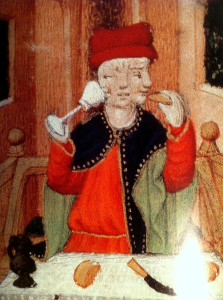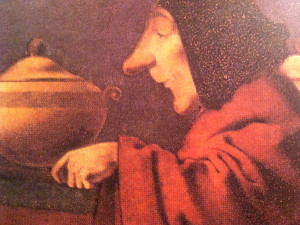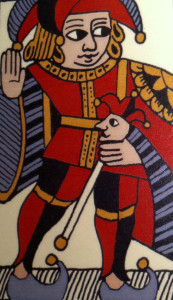SIXTH DAY of CHRISTMAS:
New Year’s Eve, Hogmanay, First Footing
Just as the Roman god Janus looks back on the old year and forward to the new, so do these Twelve Days of Christmas, half of which fall in the old year and half in the new. The month of January is named for Janus, a fitting tribute, for Janus does what we do as we cross that threshold, laying to rest the old year that has died, rejoicing in the new year now born.
Most all of us have traditions we follow at this threshold. Visit the grocery stores here in Lake Worth and the first thing you’ll see upon entering are black eyed peas and fresh collard greens, and not too far from them, champagne and grapes. Champagne at midnight on New Year’s Eve is, I think, pretty universal. The peas and greens are traditional New Year foods here in the South. As for the grapes, well, one old Italian tradition in my family is to eat twelve grapes at midnight, which we rarely do, but my sister has already bought the grapes and so this year, we are. On my dad’s side, Grandma Cutrone used to make sure everyone had a spoonful of lentils at the stroke of midnight.
In fact, the humble earthy lentil, cooked in various savory dishes, is very big throughout Italy for Capo d’Anno, the New Year. Lentils symbolize riches (think of each lentil as a coin, and you’d have quite a stash in each bowl). “Out with the old” is also very big in Italy for New Year’s Eve, and Italians traditionally make a clean sweep of things at midnight, opening the windows and tossing old useless possessions out onto the streets, no matter from what height (and with great gusto, no less). It can be a dangerous night for a walk about! The act is rich in symbolism, though: this is a night to shed what is unwanted, to dispel bad energy, to clear the way for good things to come.
In Scotland, New Year is perhaps the height of the Christmastide celebration. The New Year’s feast takes the name Hogmanay, which is thought to be a corruption of the French au gui menez, “lead to the mistletoe,” which calls to mind the Celtic druids of yore, for whom the mistletoe was sacred: the druids would climb the highest oaks with a golden sickle to cut the mistletoe that grew in its upper branches and bring it down (from the heavens) for the people.
Hogmanay has been celebrated in Scotland with great enthusiasm for centuries. As the bells tolled midnight, all of the doors and windows were flung open to let the old year out and to welcome in the new. This would be accompanied by exuberant banging of pots and pans, to scare off any vestiges of the old year that might remain.
One of the most important aspects of the Hogmanay celebration is known as First Footing: the first person after midnight to step across the threshold of the doorway is the person who brings fortune to the whole household. It should be the right kind of person, too, and so often families will make arrangements with a friend or acquaintance to make sure that happens, for the wrong kind of First Footer could bring bad luck for the year. The best of the First Footers, according to the custom, would be a red- or dark-haired man, and he would enter the home carrying a gift of whisky or mistletoe or else coal, bread, and salt. He would place the bread and salt on the table and the coal upon the fire. He would kiss all the women and shake hands with all the men twice: once upon entering, and once more after his gifts were given.
Here in South Florida, one of the most culturally diverse regions of the world, there are all kinds of customs for bringing in the new year. Fireworks go off at midnight. One friend of ours, who is from Honduras, gathers with his family and they all take turns running around the house with luggage. This, I think, ensures travels in the coming year. Another friend, who is also from Latin America, has a custom where everyone in attendance runs around the house at midnight donning underwear on top of their regular clothing. I have no idea what that ensures, but it’s quite a sight, I’m sure.
New Year’s Eve traditions all seem to have one thing in common: the universal wish for good things in the new year. And this is our wish, as well. Happy New Year.


